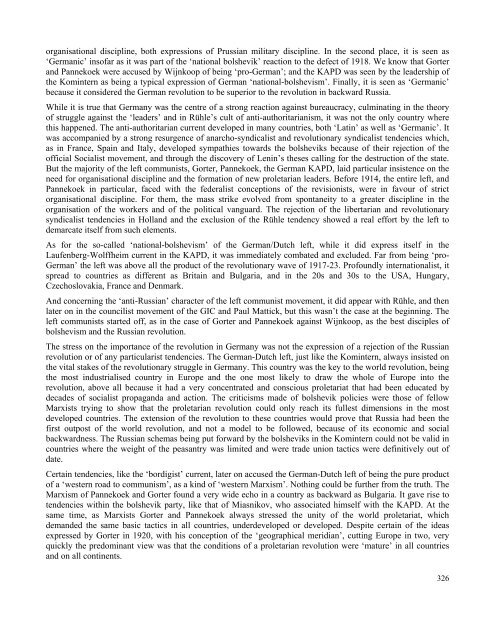The German-Dutch Communist Left - Libcom
The German-Dutch Communist Left - Libcom
The German-Dutch Communist Left - Libcom
You also want an ePaper? Increase the reach of your titles
YUMPU automatically turns print PDFs into web optimized ePapers that Google loves.
organisational discipline, both expressions of Prussian military discipline. In the second place, it is seen as<br />
‘<strong>German</strong>ic’ insofar as it was part of the ‘national bolshevik’ reaction to the defect of 1918. We know that Gorter<br />
and Pannekoek were accused by Wijnkoop of being ‘pro-<strong>German</strong>’; and the KAPD was seen by the leadership of<br />
the Komintern as being a typical expression of <strong>German</strong> ‘national-bolshevism’. Finally, it is seen as ‘<strong>German</strong>ic’<br />
because it considered the <strong>German</strong> revolution to be superior to the revolution in backward Russia.<br />
While it is true that <strong>German</strong>y was the centre of a strong reaction against bureaucracy, culminating in the theory<br />
of struggle against the ‘leaders’ and in Rühle’s cult of anti-authoritarianism, it was not the only country where<br />
this happened. <strong>The</strong> anti-authoritarian current developed in many countries, both ‘Latin’ as well as ‘<strong>German</strong>ic’. It<br />
was accompanied by a strong resurgence of anarcho-syndicalist and revolutionary syndicalist tendencies which,<br />
as in France, Spain and Italy, developed sympathies towards the bolsheviks because of their rejection of the<br />
official Socialist movement, and through the discovery of Lenin’s theses calling for the destruction of the state.<br />
But the majority of the left communists, Gorter, Pannekoek, the <strong>German</strong> KAPD, laid particular insistence on the<br />
need for organisational discipline and the formation of new proletarian leaders. Before 1914, the entire left, and<br />
Pannekoek in particular, faced with the federalist conceptions of the revisionists, were in favour of strict<br />
organisational discipline. For them, the mass strike evolved from spontaneity to a greater discipline in the<br />
organisation of the workers and of the political vanguard. <strong>The</strong> rejection of the libertarian and revolutionary<br />
syndicalist tendencies in Holland and the exclusion of the Rühle tendency showed a real effort by the left to<br />
demarcate itself from such elements.<br />
As for the so-called ‘national-bolshevism’ of the <strong>German</strong>/<strong>Dutch</strong> left, while it did express itself in the<br />
Laufenberg-Wolffheim current in the KAPD, it was immediately combated and excluded. Far from being ‘pro-<br />
<strong>German</strong>’ the left was above all the product of the revolutionary wave of 1917-23. Profoundly internationalist, it<br />
spread to countries as different as Britain and Bulgaria, and in the 20s and 30s to the USA, Hungary,<br />
Czechoslovakia, France and Denmark.<br />
And concerning the ‘anti-Russian’ character of the left communist movement, it did appear with Rühle, and then<br />
later on in the councilist movement of the GIC and Paul Mattick, but this wasn’t the case at the beginning. <strong>The</strong><br />
left communists started off, as in the case of Gorter and Pannekoek against Wijnkoop, as the best disciples of<br />
bolshevism and the Russian revolution.<br />
<strong>The</strong> stress on the importance of the revolution in <strong>German</strong>y was not the expression of a rejection of the Russian<br />
revolution or of any particularist tendencies. <strong>The</strong> <strong>German</strong>-<strong>Dutch</strong> left, just like the Komintern, always insisted on<br />
the vital stakes of the revolutionary struggle in <strong>German</strong>y. This country was the key to the world revolution, being<br />
the most industrialised country in Europe and the one most likely to draw the whole of Europe into the<br />
revolution, above all because it had a very concentrated and conscious proletariat that had been educated by<br />
decades of socialist propaganda and action. <strong>The</strong> criticisms made of bolshevik policies were those of fellow<br />
Marxists trying to show that the proletarian revolution could only reach its fullest dimensions in the most<br />
developed countries. <strong>The</strong> extension of the revolution to these countries would prove that Russia had been the<br />
first outpost of the world revolution, and not a model to be followed, because of its economic and social<br />
backwardness. <strong>The</strong> Russian schemas being put forward by the bolsheviks in the Komintern could not be valid in<br />
countries where the weight of the peasantry was limited and were trade union tactics were definitively out of<br />
date.<br />
Certain tendencies, like the ‘bordigist’ current, later on accused the <strong>German</strong>-<strong>Dutch</strong> left of being the pure product<br />
of a ‘western road to communism’, as a kind of ‘western Marxism’. Nothing could be further from the truth. <strong>The</strong><br />
Marxism of Pannekoek and Gorter found a very wide echo in a country as backward as Bulgaria. It gave rise to<br />
tendencies within the bolshevik party, like that of Miasnikov, who associated himself with the KAPD. At the<br />
same time, as Marxists Gorter and Pannekoek always stressed the unity of the world proletariat, which<br />
demanded the same basic tactics in all countries, underdeveloped or developed. Despite certain of the ideas<br />
expressed by Gorter in 1920, with his conception of the ‘geographical meridian’, cutting Europe in two, very<br />
quickly the predominant view was that the conditions of a proletarian revolution were ‘mature’ in all countries<br />
and on all continents.<br />
326
















